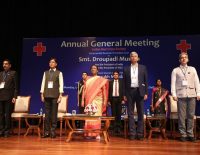Newborn care practices as skin-to-skin contact in first hour of birth very low: WHO

The global health body World Health Organization has said that some indicators have not changed over time, such as 65% of women accessing post-natal contact with a health care provider within two days after birth and less than half of newborns getting breastfed within the first hours of birth.
There is little data on implementation of essential newborn care practices such as skin-to-skin contact in the first hour of birth, while the coverage of life-saving oral rehydration salts for children with diarrhoea continues to be low (55%), and only 64% of children with suspected pneumonia are taken to a health care provider, the WHO said.
To accelerate further reduction of maternal, newborn and child deaths in the WHO South-East Asia Region, health officials and experts are deliberating strategies and interventions to address gaps in quality and equitable health services for everyone everywhere at Colombo.
“The Region has made significant gains in mortality reduction but progress within countries has been uneven. We must adopt a differential approach to further reduce maternal, newborn, and child mortality based on their contextual priorities, available resources and new WHO guidelines and standards,” said Dr Poonam Khetrapal Singh, Regional Director, WHO South-East Asia.
While the regional averages for evidence-based high-impact interventions across the Reproductive, Maternal, Newborn, Child, and Adolescent Health (RMNCAH) life course have increased over the past decade; they are yet to reach the universal coverage levels of 90% or more.
“It is important that while we sustain gains made in achieving high coverage of intervention packages such as skilled birth attendants and immunization, we must also explore innovative solutions to accelerate actions aimed at improving service delivery gaps and the quality and coverage of interventions such as intrapartum care, breastfeeding, care of preterm and low birth weight infants, and birth defect prevention,” said Dr Khetrapal Singh.
Since 2014, the Region has been focusing efforts to reduce maternal, newborn and child deaths, as a flagship priority, by implementing evidence-based strategies and actions.
As a result, the Region experienced a steep drop in death rates. The maternal mortality (MMR) in the Region fell by 41% compared to 12% globally between 2010 and 2020. Seven countries (Bangladesh, Bhutan, DPR Korea, India, Maldives, Sri Lanka, and Thailand) achieved the target of below 140 per 100 000 live births while four countries (Bangladesh, Myanmar, Nepal, and Timor-Leste) are likely to achieve national-level targets of a two-thirds reduction in MMR from 2010 value.
Under-5 mortality (U5MR) reduced by 45% between 2010 and 2021, compared to a 26% global reduction with five countries (DPR Korea, Indonesia, Maldives, Sri Lanka, and Thailand) achieving Sustainable Development Goal (SDG) target of as low as 25 per 1000 live births, another four countries (Bangladesh, Bhutan, India, Nepal) are on track for this.
The newborn mortality (NMR) has almost halved, with the Region recording a 40% reduction compared to a global 22% drop during the same period. Five countries (DPR Korea, Indonesia, Maldives, Sri Lanka, and Thailand) have achieved the SDG NMR target of neonatal mortality of 12 per 1000 live births while another four (Bangladesh, Bhutan, India, and Nepal) are on track to achieve this target by 2030. “We must make a strategic shift to a life-course approach that goes beyond survival, to ensure that women and children thrive and achieve their full potential for health and well-being,” said Dr Poonam Khetrapal Singh.








Comments